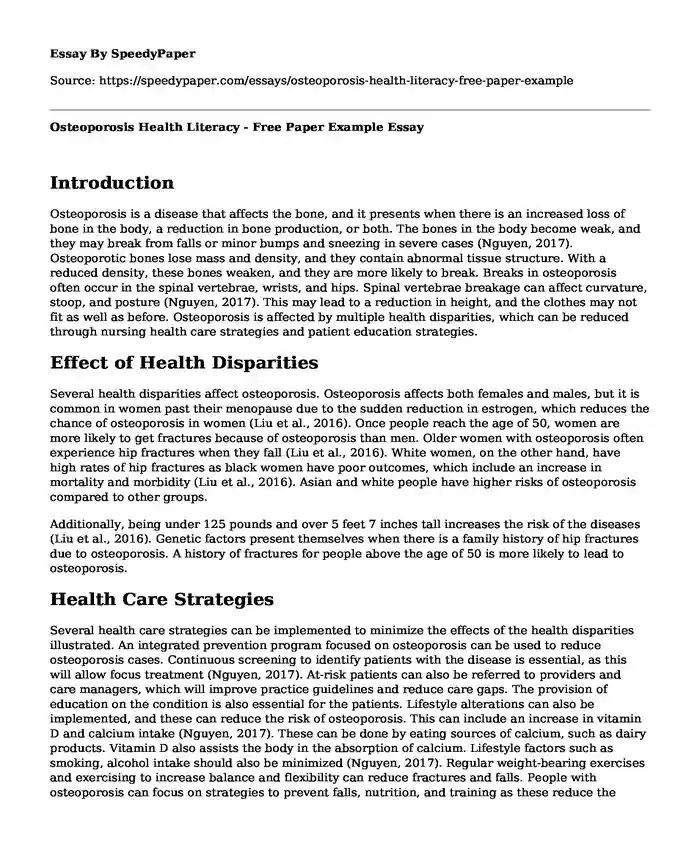
| Type of paper: | Essay |
| Categories: | Nursing Healthcare |
| Pages: | 3 |
| Wordcount: | 772 words |
Introduction
Osteoporosis is a disease that affects the bone, and it presents when there is an increased loss of bone in the body, a reduction in bone production, or both. The bones in the body become weak, and they may break from falls or minor bumps and sneezing in severe cases (Nguyen, 2017). Osteoporotic bones lose mass and density, and they contain abnormal tissue structure. With a reduced density, these bones weaken, and they are more likely to break. Breaks in osteoporosis often occur in the spinal vertebrae, wrists, and hips. Spinal vertebrae breakage can affect curvature, stoop, and posture (Nguyen, 2017). This may lead to a reduction in height, and the clothes may not fit as well as before. Osteoporosis is affected by multiple health disparities, which can be reduced through nursing health care strategies and patient education strategies.
Effect of Health Disparities
Several health disparities affect osteoporosis. Osteoporosis affects both females and males, but it is common in women past their menopause due to the sudden reduction in estrogen, which reduces the chance of osteoporosis in women (Liu et al., 2016). Once people reach the age of 50, women are more likely to get fractures because of osteoporosis than men. Older women with osteoporosis often experience hip fractures when they fall (Liu et al., 2016). White women, on the other hand, have high rates of hip fractures as black women have poor outcomes, which include an increase in mortality and morbidity (Liu et al., 2016). Asian and white people have higher risks of osteoporosis compared to other groups.
Additionally, being under 125 pounds and over 5 feet 7 inches tall increases the risk of the diseases (Liu et al., 2016). Genetic factors present themselves when there is a family history of hip fractures due to osteoporosis. A history of fractures for people above the age of 50 is more likely to lead to osteoporosis.
Health Care Strategies
Several health care strategies can be implemented to minimize the effects of the health disparities illustrated. An integrated prevention program focused on osteoporosis can be used to reduce osteoporosis cases. Continuous screening to identify patients with the disease is essential, as this will allow focus treatment (Nguyen, 2017). At-risk patients can also be referred to providers and care managers, which will improve practice guidelines and reduce care gaps. The provision of education on the condition is also essential for the patients. Lifestyle alterations can also be implemented, and these can reduce the risk of osteoporosis. This can include an increase in vitamin D and calcium intake (Nguyen, 2017). These can be done by eating sources of calcium, such as dairy products. Vitamin D also assists the body in the absorption of calcium. Lifestyle factors such as smoking, alcohol intake should also be minimized (Nguyen, 2017). Regular weight-bearing exercises and exercising to increase balance and flexibility can reduce fractures and falls. People with osteoporosis can focus on strategies to prevent falls, nutrition, and training as these reduce the cases of fractures and rates of bone loss.
Patient Education Strategies
Patient education strategies can be implemented to improve health literacy on osteoporosis. This can be done by taking advantage of technology, which helps make resources more accessible (Nguyen, 2017). Additionally, determining the patient's learning style is essential, as this will maximize the teaching's reinforcement. It will ensure that the right methods are used, which increases understanding of the disease (Nguyen, 2017). Involving family members is essential in the provision of education. In this case, most of the instruction will be provided to the family members who will have a vital role in managing healthcare.
Conclusion
Osteoporosis is a disease that affects the bone, and it presents when there is an increased loss of bone in the body, a reduction in bone production, or both. Osteoporosis is affected by multiple health disparities, which can be reduced through nursing health care strategies and patient education strategies. Osteoporosis affects both females and males but occurs more in women after post-menopause due to their sudden estrogen reduction. It also affects taller people, most of the Asian and white ethnic groups. Continuous screening is essential among high-risk communities. These can assist in starting prevention measures such as increasing calcium and vitamin D consumption increasing. Avoiding alcohol and cigarette consumption and increasing exercise. These can be improved by focusing on patient education with the use of technology and involving family members.
References
Nguyen, V. (2017). Osteoporosis prevention and osteoporosis exercise in community-based public health programs. Osteoporosis And Sarcopenia, 3(1), 18-31.
https://doi.org/10.1016/j.afos.2016.11.004
Liu, Z., Weaver, J., de Papp, A., Li, Z., Martin, J., & Allen, K. et al. (2015). Disparities in osteoporosis treatments. Osteoporosis International, 27(2), 509-519.
https://doi.org/10.1007/s00198-015-3249-0.
Cite this page
Osteoporosis Health Literacy - Free Paper Example. (2023, Nov 24). Retrieved from https://speedypaper.net/essays/osteoporosis-health-literacy-free-paper-example
Request Removal
If you are the original author of this essay and no longer wish to have it published on the SpeedyPaper website, please click below to request its removal:
- Locked-in Syndrome Essay Example
- Wellness on Tobacco. Free Essay Example.
- The Role of Community Health Nursing and Community Partnerships - Essay Sample
- Essay Sample on Reason for Restaurants to Change Their Menu
- Free Essay. Assessing and Treating Clients with Impulsivity, Compulsivity, and Addiction
- Paper Example: Free Enterprise Policies in America During the Covid-19 Pandemic
- An In-Depth Analysis of Health Technology Assessment in India Amidst the COVID-19 Pandemic - Free Paper
Popular categories




